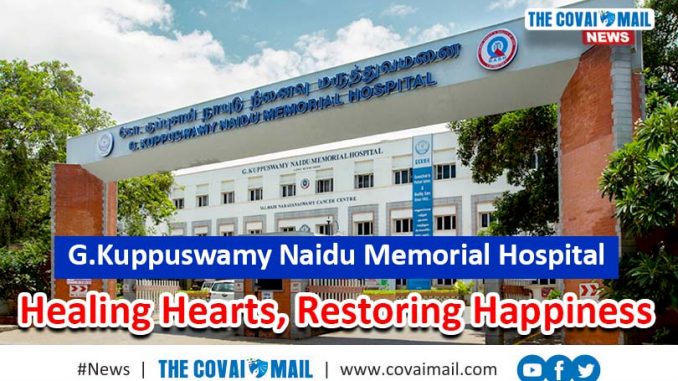
World Heart Day (September 29) is that one special day that tries to draw all our attention towards Heart, the organ that works for us 24/7. Doctors, Hospitals and NGOs come together on this day to create awareness about Heart-Health and also help us know more about the ways to keep our hearts safe.

If we look at the data from a recent study by World Heart Federation, it points out that Cardio Vascular Disease (CVD) causes over 18.6 million deaths per year, and it remains the world’s number one killer. This is yet another example that as our species thrives in other domains, it often forgets to pay attention to its mental and physical well-being.
But thanks to the developments in the field of medicine and medical-technology, we have expert doctors and hospitals that can heal the hearts that have become victims of the diseases.
G.Kuppuswamy Naidu Memorial Hospital at Coimbatore is one of the few trusted names in this part of Country that has some of the well-seasoned Cardiologists, Cardiothoracic Surgeons and State of the art infrastructure in the whole of India, who work together as a Cardiac Team, and treat patients ranging from newborns to octogenarians with wonderful results.
It must be mentioned that GKNMH is the first institution in the region to translate to the public the needs of primary angioplasty and how it helps to get relief from heart-attack. It is the first to perform Percutaneous Aortic Valve Replacement procedure (replacing heart valves without doing surgery)
While Treatment is part of the process, staying aware of risk factors that lead to heart diseases is also crucial. Ahead of the World Heart Day 2021, the Cardiologists and Cardiac Surgeons shared their insights about heart diseases, heart-health management and the treatments available for heart-related ailments, in the interest of public welfare.
Beating strong since 1974!
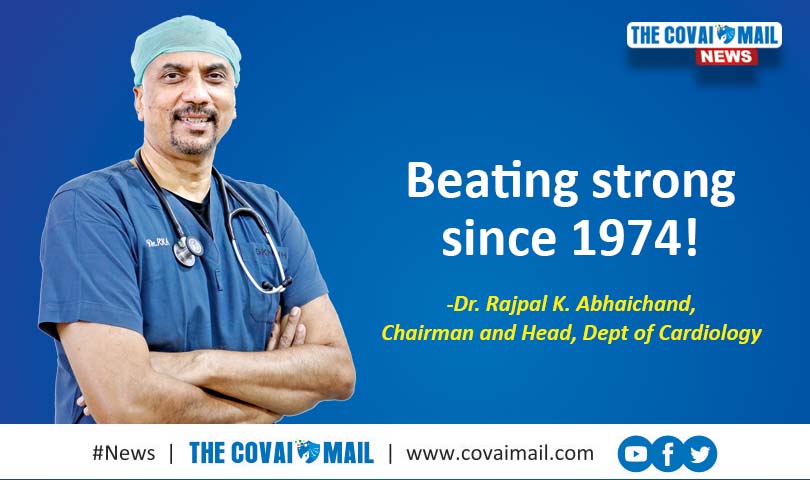
-Dr. Rajpal K. Abhaichand, Chairman and Head, Dept of Cardiology
“GKNMH started the Cardiology Department in 1974, and it has come a long way since then. Initially it was a three bedded ICU which was functioning in the present C Block. Now it has become a massive structure and the pinnacle of cardiac treatment in this country” says Dr.Rajpal, Chairman, Department of Cardiology, GKNMH
“We have taken large steps forward, continued to keep pace with the times, continued to increase our infrastructure, and make sure that we have the best of equipment and people, and provide services.”
“We get patients from Coimbatore and various other States as we have enormous ‘Trust bank’ on which this hospital actually thrives. We have continued to upgrade ourselves technology-wise, we now have 3 state of the art cardiac cathlabs, one electrophysiological catlab and one pedicatric interventional cardiology cathlab.”
“We have been updating our technology, increasing our expertise and enhancing our infrastructure and total services towards bettering the lives of our patients, as we are a patient-first, Charitable Trust-run Quaternary Care hospital.”
The Right Lifestyle
The Way for a Happy Heart!
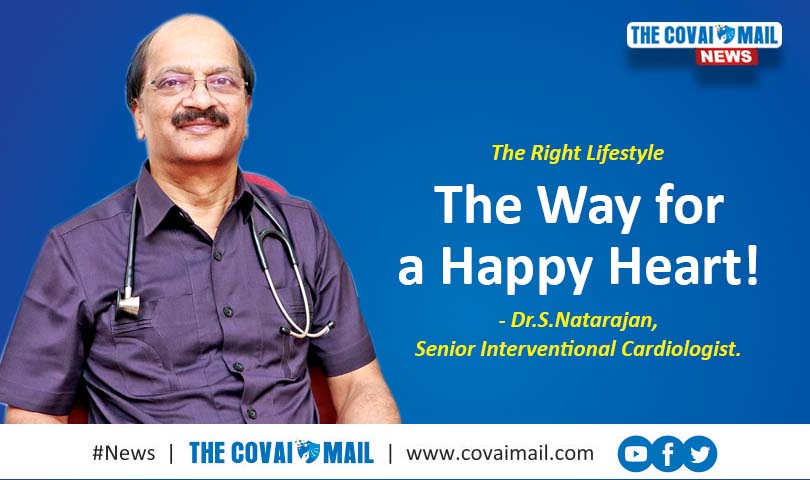
-Dr.S.Natarajan, Senior Interventional Cardiologist.
Heart Disease is no longer the disease of the elderly population. Even youngsters are facing it, and one of the prime cause for that is faulty Lifestyle.
By eating food with high fat, sugar/salt and starch, the cholesterol level in our blood will increase over a period of time. When the blood flows through the blood vessels, the cholesterol content present in it will slowly start to settle in some areas of the vessels, and gradually decrease its lumen.
As that happens, the flow of blood is obviously going to get reduced, and this will result in heart ailments, which otherwise could be avoided if a person focuses on heart healthy diet.
Also note that too much intake of food and too little physical activity will certainly increase the fat in the body, and this will settle in your waist, making it large. All these will increase your risk of heart attack. Apart from this, if a person takes tobacco regardless of whether it is taken via smoking, chewing or sniffing, it will unleash several chemicals into his body, and poison his heart slowly.
On this World Heart Day, I urge all of you to follow a healthy lifestyle, engage in physical activities like cycling, jogging swimming or brisk walking whichever is comfortable for you to keep your heart healthy.
Chronic Mental Stress
Don’t let it steal your health & joy
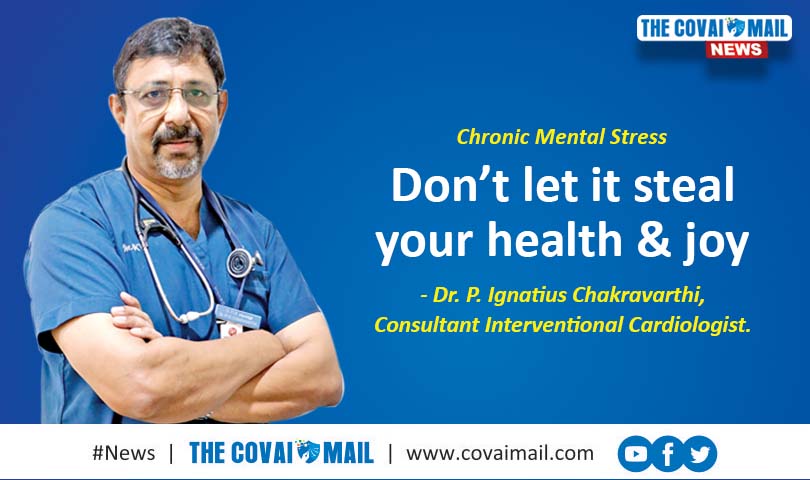
Dr. P. Ignatius Chakravarthi, Consultant Interventional Cardiologist.
The risk factors for heart attack were usually Diabetes, Obesity, Hyper Tension etc but in the recent years, Chronic Mental Stress has become an equal cause of Heart Diseases, especially in the last 2 years, and sadly we are seeing more young patients (between 20 and 30 years) getting heart attacks due to this factor.
When we are under stress, our body releases some hormones like Cortisol, Catecholamines as an adaptive response. These hormones create needed energy to survive the tough ‘stressful’ scenarios. If we are continuously under stress, these hormones will be released often, causing an imbalance in their secretion and also shoot up the blood pressure and sugar level. These increase the possibility of suffering heart attack.
Stress can also make a person follow poor lifestyle practices like smoking, increased junk-food consumption among other issues, which silently steal his health. Hence we must take care of ourselves by being firm that whatever hardships come, we should overcome it with a positive, cheerful attitude.
We should develop habits that will keep us happy in times of hardships. Life is short, we must find good ways to keep us cheerful. If we do that, our body will release Happy Hormones which will keep us relaxed and rejuvenated. So talk to a friend, follow a good hobby, take a walk, do yoga and practice positive things to cut stress out.
Coronary Angiogram
Pictures tell us the story!
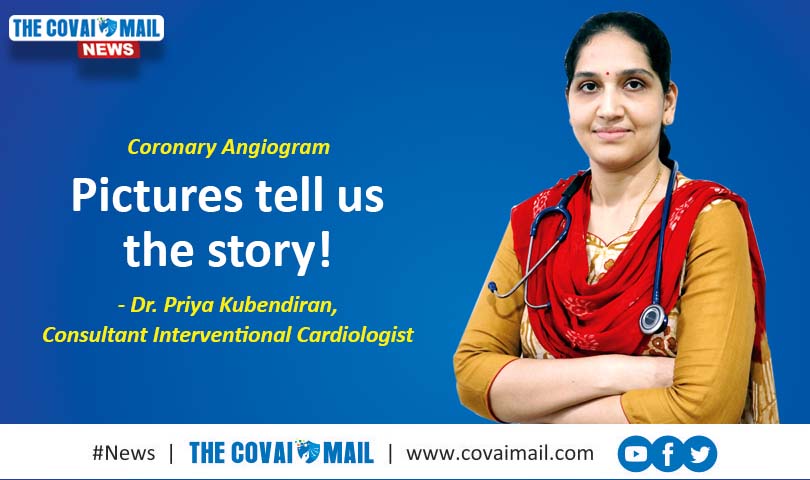
-Dr. Priya Kubendiran, Consultant Interventional Cardiologist.
When patients arrive with pain in the chest, it could be because of reduced blood flow to the heart, caused either by an underlying narrowing of the blood vessel or a clot which blocks the blood vessel completely. So we do an angiogram to determine it. We will make a very minute incision and find the main artery in the wrist. Then, a type of dye that is visible under x-ray scan is injected into the coronary artery through a catheter.
The cath lab machine then takes a series of pictures and produce images of the vessels which will give us the location of the block/narrowing in the blood vessels. After this, we will decide on further course of treatment (medicines only/stenting/by pass surgery).
When the chest pain occurs only when specific activities are done by the patient, like walking, climbing stairs, the test and treatment are done as an elective procedure but when they arrive with heart attack, it is done as an emergency along with stenting.
We have three excellent cath labs, and with the advancements today, angiogram can be done as a day-care procedure, and angioplasty is done in a much shorter duration than earlier days.
Primary Angioplasty
A Life-Saving Procedure
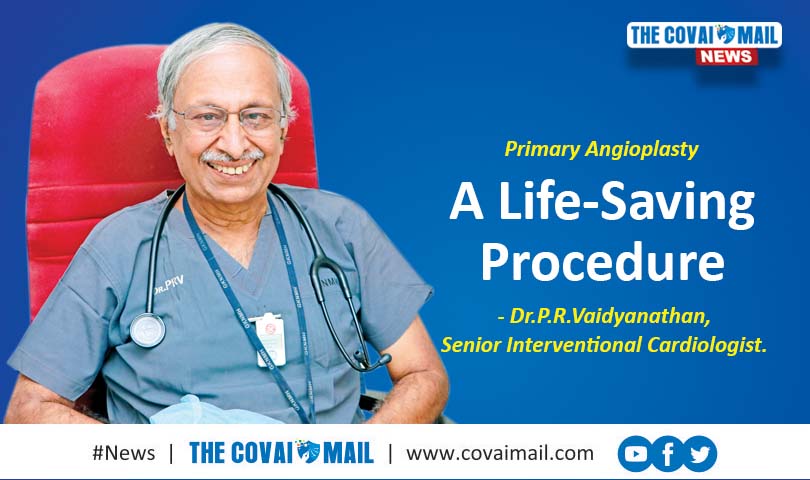
-P.R.Vaidyanathan, Senior Interventional Cardiologist.
If you have too many cholesterol particles in your blood, cholesterol may accumulate on your artery walls. Eventually, these deposits called ‘plaques’ may form.
Plaque can produce partial blocks. Sometime damage may occur to this and blood clot could form over that and completely block the blood vessel. This leads to a heart attack.
Once we establish that a patient at our premises has arrived in this condition via Angiogram, we quickly evaluate him/her and go for Primary Angioplasty.
This treatment is considered to be the best in helping patients suffering heart attack. We will make a very minute puncture, and find the main artery in the lower arm, and gently insert a thin tube (catheter). Through the catheter, we pass a wire and keep it beyond the block and then take a balloon which is blown up, to help in removal of the block.
After this, a metal mesh called ‘Stent’ will be placed at the spot where the block was present so that the flow of blood will be ensured after the removal of the block.
Earlier, a clot-busting medicine was used but only one 30 in 100 stand to benefit from this. Primary Angioplasty on the other hand can help patients in much better way. At GKNMH we have been doing this for the past two decades. All of us at the Department have the expertise to do this procedure whenever a patient arrives at the hospital, whether it is day or night, we do this 24/7. At GKNMH, we have done more than 1 lakh angioplasty procedures.
For best results the patients have to arrive within one to three hours of the attack. If they arrive after 3 hours, if they delay, it will lead to heart muscle’s damage. So ‘Time is Muscle’ here, hence patients should consider arriving immediately.
Intravascular Ultrasound & Optical Coherence Tomography
Precision beyond normal vision
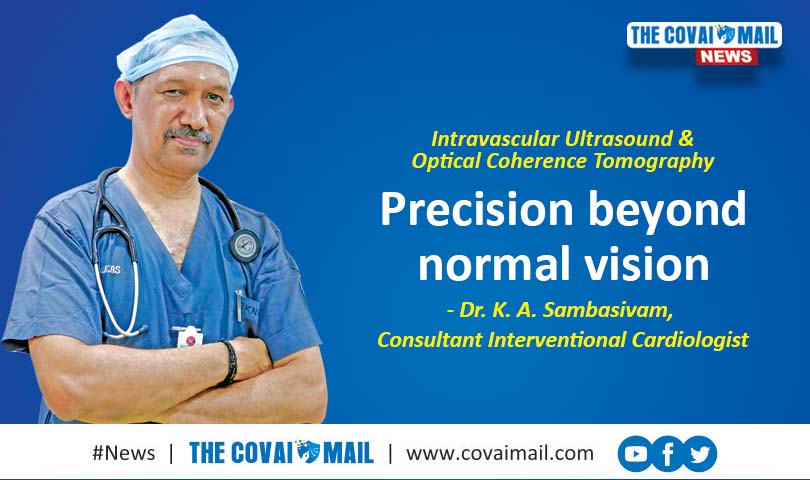
K. A. Sambasivam, Consultant Interventional Cardiologist, GKNMH
While Angiogram helps in identifying the blocks in heart’s blood vessels, the recent advancements like Intravascular Ultrasound and Optical Coherence Tomography have been incredible value-adders in the field of interventional Cardiology.
These are Invasive imaging modalities. They get into the body like how a catheter is sent via the arm or leg. These tools help cardiologists in identifying whether a block or narrowing in heart coronary arteries are to be subjected for procedures like stent or bypass or can be managed otherwise, if stenting is required and whether additional treatment tools are required before stenting and to optimize stenting.
They also help us in finding whether the stent placed is expanded well in the place it has been deployed, see whether the stent and the blood vessel’s diameter match, help us in identifying the presence of very minute blocks if any, find out if there are any damages to the blood vessel at its edge, etc. These modalities add value to the service we offer here.
Rotablation & Lithotripsy
We clear the hardest blocks
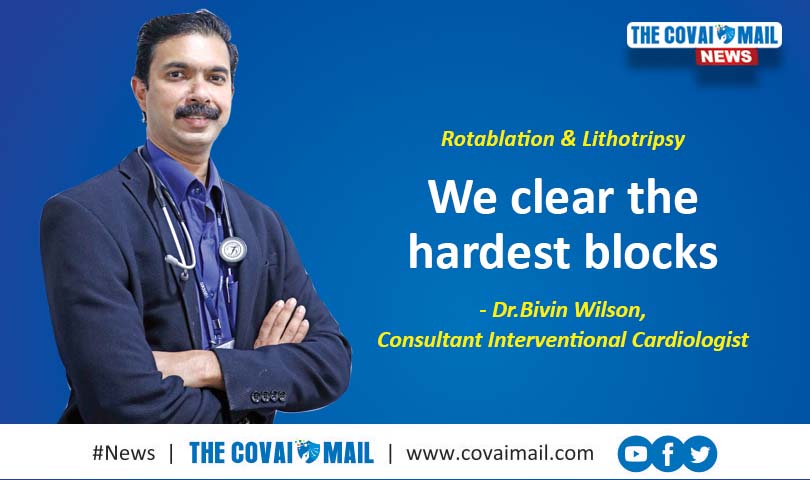
Dr.Bivin Wilson, Consultant Interventional Cardiologist.
When there is a block in the blood vessels of the heart, we do angioplasty procedure using a balloon. But if the block is hard because of the deposition of calcium over a long period of time, clearing the block using the usual techniques will not help. In this scenario we have options like rotablation or shockwave lithotripsy.
Rotablation is a complex technique where a drilling is done in the blood vessels with a diamond-tipped burr which will remove the calcium and facilitate further ballooning and stenting. Though it is a very risky procedure, in trained hands the risk is very low.
In some cases, apart from the superficial calcium, there will be deep calcium in the blood vessels, where rotablation may not help us. In this situation we may have to resort to a new technique called Intravascular Shockwave Lithotripsy. It operates on the principle ‘Hard on Hard, Soft on Soft’.
Here acoustic waves are created which modify or fracture the deep calcium without affecting the normal tissues. So it won’t cause perforations of the blood vessels and is very safe. In our state of the art Cathlab at GKNMH, we have both these facilities available to treat such complex calcified lesions.
Electrophysiology
Solving the power issues of the Heart
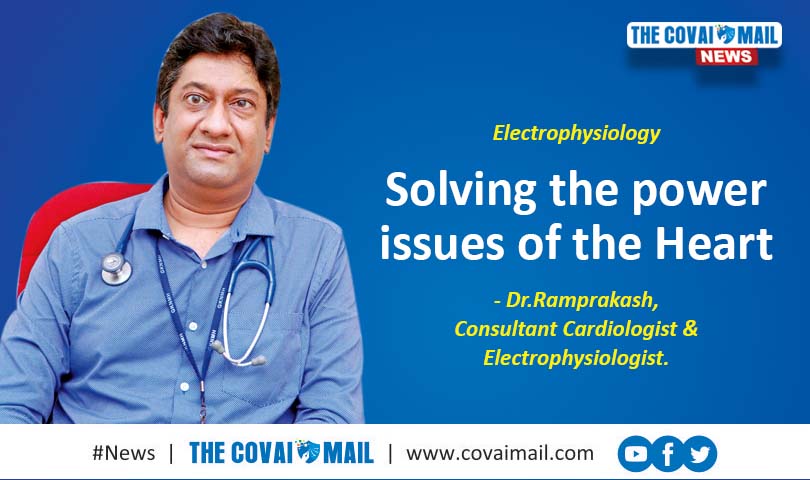
Dr.Ramprakash, Consultant Cardiologist & Electrophysiologist.
Our heart does not need help from the brain to keep beating because it has its own electrical system. This system powers the organ to pump the blood into the body and that is the reason why it can continue to beat for a short time after brain death, or after being removed from the body.
When the beating of the heart and the pulse in our body drops low or shoots up than their optimal level, it can cause serious trouble the heart, and can even be lethal to the person.
The cause for the irregularity in the heartbeat (Arrhythmia) and pulse may be due to age related degeneration of heart, an issue with the electrical conduction system of the heart, a block in the blood vessels, among many other causes. To normalize the abnormal pulses, we implant a pacemaker. It generates electrical impulses and helps to regulate the function of the electrical conduction system of the heart.
When a short circuit happens in the system, it could lead to palpitation. People should know that that if the palpitation occurs from upper chamber of the heart (Atrium) it would not be life-threatening but can trigger fatigue, giddiness etc. But if the palpitation stems from lower chambers (ventricle), it is lethal. Depending on the type of issue, we provide Radiofrequency ablation or implant a mini Defibrillator.
Heart disease arising due to the organ’s electrical issues can occur in any age group, even in a fetus but thanks to advancements in science, we have the experts and the equipment to treat the simplest heart-beat issues to the complex problems. In fact, we have placed 2000 pacemakers and ICD devices, 2500-3000 RF Ablations in the past 10-12 years. We specialize in dealing with these issues.
Valve Replacement
We are the pioneers
-Dr. Rajpal K. Abhaichand, Chairman and Head, Dept of Cardiology
The latest technology that has taken a jump is percutaneous replacement of valves, and we are the pioneers of that procedure in this part of the country.
We are able to do this wonderful procedure seamlessly. Usually what was a surgical procedure requiring 7-8 days of hospitalization is now being done percutaneously through a small 2 to 3 mm hole in the leg.
Initially people were little weary of this procedure but this is safe and efficacious. The morbidity and Mortality that existed earlier has certainly come down following this procedure when done percutaneously.
This is especially very useful in people who are a little older and this who will not tolerate surgery very well.
With the increasing safety and efficacy of this procedure, even younger people with valve problem requiring replacement are willing to go for this procedure. We are gradually expanding the indication to a large segment of the population.
Heart Failure
We strive to make Hearts win
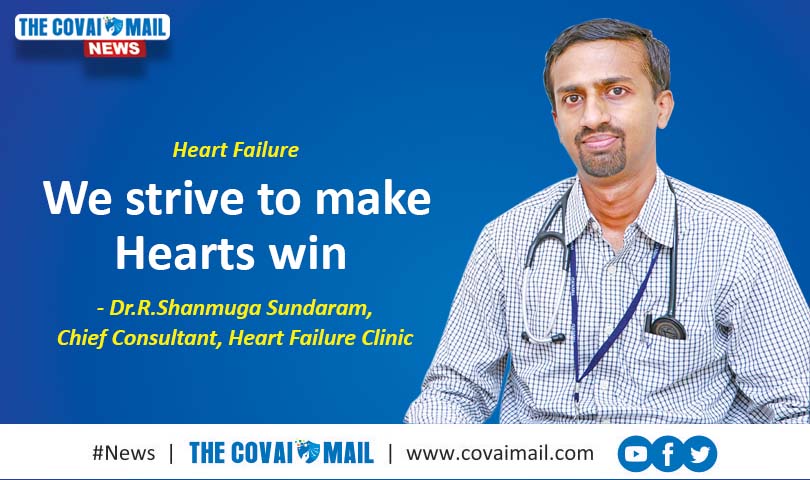
Dr.R.Shanmuga Sundaram, Chief Consultant, Heart Failure Clinic.
Primary function of the Heart is to pump blood into our body. When heart muscles fail to pump enough blood as it should be or when it pumps in a strained manner, it leads to a condition called Heart Failure. When this occurs, blood often backs up and fluid can build up in lungs, which can cause shortness of breath while doing regular activities.
There are many causes that lead to Heart Failure. Patient may have blocks in the blood vessels which are supplying heart muscles, or they might have had heart attack previously which subsequently weakens the heart muscles. Uncontrolled Blood pressure for a long time may weaken heart muscles as well. Improper functioning of valves within the heart can lead to Heart failure if not addressed properly.
Problem with this disease is that it may not reveal its presence at earlier stages. Patients may have some minor symptoms like inability to do his daily routine activities, mild breathing difficulty on exertion. By the time patient seeks medical attention patients might be at their advanced stage of the illness.
For early detection and appropriate management of this illness, we have established a dedicated multidisciplinary Heart Failure Clinic. Heart failure multidisciplinary team includes a Cardiologist who is trained in management of advanced heart failure, a trained Heart failure nurse who are involved in patient counselling, a Physiotherapist who guides the patients for rehabilitation which helps in early recovery, Cardiac surgeons who performs surgical procedures in these patients if warranted and an Electrophysiologist who implants devices which might improve the pumping efficiency of the heart.
Management of patients with Heart failure is multipronged. After evaluation, patients are guided for appropriate lifestyle changes and physical activities. They are enrolled in Rehabilitation programme. Depending upon the nature of the illness they are suggested angiogram to look for blocks and if needed angioplasty or bypass surgery to remove those blocks. If warranted patients are suggested surgical or nonsurgical treatment options for valvular problems. Some patients might warrant implantation of device therapy which may help the heart to improve its pumping efficiency.
If above mentioned treatment options fail to improve the condition of the patient or if not feasible, then we might have to consider advanced treatment options like implantation of artificial mechanical pumps which will assist the existing heart or Heart transplantation where we remove the diseased heart and implant a heart from a brain dead donor.
Pediatric Cardiology
We make little hearts live long
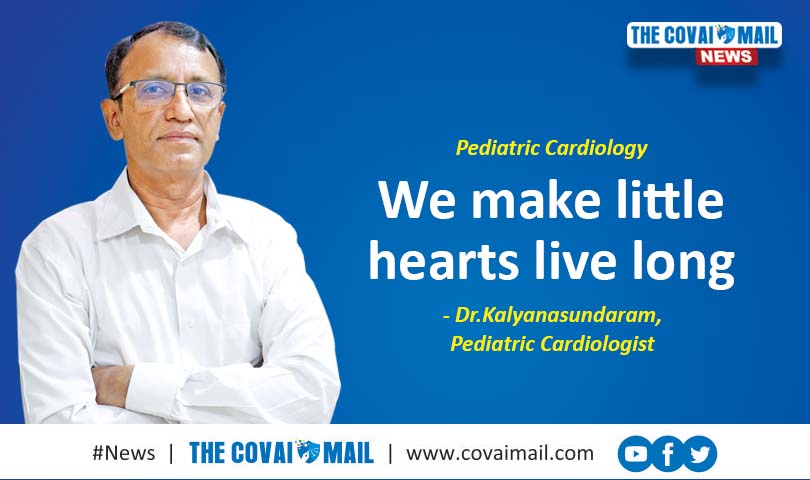
– Dr.Kalyanasundaram, Pediatric Cardiologist
Children are either born with heart ailments like hole in the heart, blocks in the valves and blood vessels called congenital heart diseases or they get heart diseases after birth called acquired heart diseases. Hereditary also plays a role here but that is small. If new-borns catch recurrent attacks of cold, not gaining weight, breathing problem, fatigue state etc., parents should be very cautious.
Some babies exhibit a visible condition called cyanosis. This is a condition where the blood of the baby has less oxygen in it due to heart issues. This makes the new-borns’ skin appear with a bluish hue. These are symptoms that shouldn’t be ignored.
With the advancements today, all types of pediatric heart disease can be treated either via surgery or through minimally invasive procedures without open heart surgery. As far as congenital heart disease is concerned, complete cure is possible, as the risk factors don’t stay with the children like it does in adults.
Holes can be fixed, blocks can be cleared, valves can be corrected, and the children can live a near normal life without fear. Only 10% will require a repeat surgery or minimally invasive procedures to correct the heart issue.
At GKNM, we have the infrastructure and the expertise to treat newborns and children with simple to complex heart diseases. For decades, we have treated such cases and have given very good results.
All-round heart care, 24/7
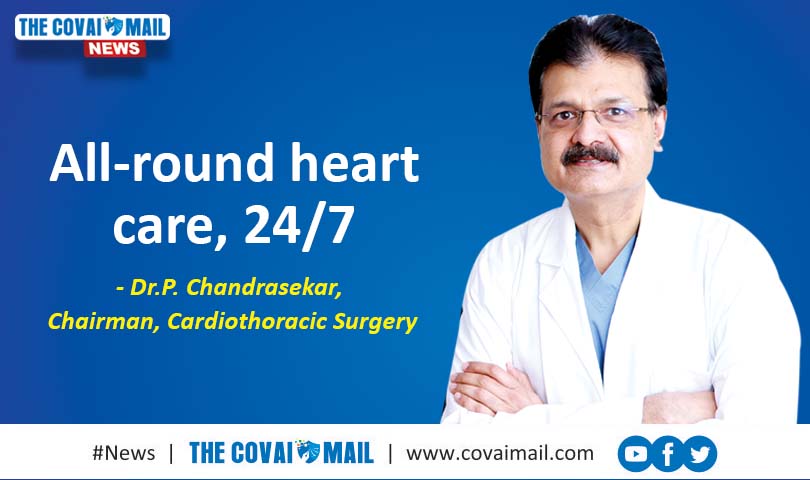
– Dr. P. Chandrasekar, Chairman, Cardiothoracic Surgery, GKNMH.
The Department of Cardiothoracic Surgery at GKNMH was established in the year 1974, and it was the first to be started in this city and region.
Since then, this center has performed more than 30,000 open heart procedures. Today it is one of the top 20 centers in the country doing about 1800 cardiac procedures every year.
It has a very skilled team of surgeons, anesthesiologist, intensivist, perfusionist, nurses and other paramedical staff.
The center does all cardiac procedures, right from surgery on the newborns to cardiac transplantations. The center is a center of excellence in certain areas like beating heart surgery, beating heart bypass surgery and valve repair.
As a matter of fact, very few centers in India are Centers of Excellence for Valve repair, and we are one of them. We are also a Center of Excellence in Pediatric Cardiac Surgery and Aortic Surgery. We are among the top 10 centers that do complex aortic surgery including endovascular and hybrid aortic procedures. We also do minimally invasive surgery.
We also do a spectrum of Vascular and Thoracic surgery as well, and we have a cutting edge technology and state of the art infrastructure to do all complex procedures. Our team includes 3 adult cardiac and 1 Pediatric cardiac surgeon.
We have started a specialized Heart Failure Clinic and have done 3 cardiac transplants; 2 under government scheme. Appreciating our efforts in cardiac transplant, TRANSTAN awarded our team ‘The Best Performing Heart Transplant Team 2021’ award in August.
Consistent with the vision of the hospital, we provide highest quality cardiac surgery at affordable cost to patients. We stand on ethics and best clinical practices.
The quality is one of the foremost and we have quality assurance, all cases undergo transesophageal echocardiography, so that when patients leave the operation theatre, the surgical procedure is checked for 100% perfectness. For Bypass surgery we do a transit flow measurement which shows the bypass grafts are working well.
This is available in a very flow centers in the country, and it is available in GKNMH as we place high importance to quality care. Today, everyone talks of Heart-Team (i.e) a close collaboration between cardiologist and surgeon for best patient care. We were always a heart team right from beginning. That is one of the strong reasons why our cardiac care is so good. We give the patient the best possible solution.
GKNMH has also ECMO (extracorporeal membrane oxygenation) which can be done in patients needing life support. Everybody would have heard about ECMO now in the pandemic, and GKNM has also done ECMO in covid patients who had survived and gone home.
So, GKNMH Cardiac Surgery center offers A-Z of cardiac care, like from New-born till ECMO Transplantation and also Minimal Access Surgery.
Bypass Surgery
Crossing obstacles, reconnecting happiness
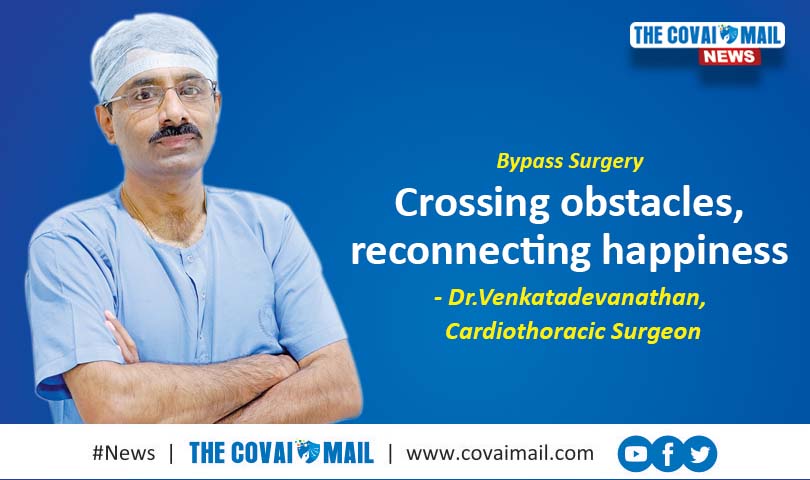
– Dr.Venkatadevanathan, Cardiothoracic Surgeon, GKNMH
Coronary Arteries supply oxygen and nutrition to the heart. When a block occurs in any part of this artery, it leads to chest pain and other serious complications. This blockage could be cleared through medicine, stenting and by surgery.
When it becomes too severe to manage the blockage through medicines and other treatments, Bypass Surgery is advised. Bypass surgery accounts for 70% of all cardiac surgical work in our country.
GKNMH is a pioneer in bypass surgery, and here we do bypass surgeries for certain heart-attack patients either as Beating Heart Surgery or with the support of Cardiopulmonary Bypass Machine. In beating-heart type of surgery, the heart will continue to beat throughout the surgery. When surgery is done with a machine’s assistance, it will act as the heart and lung for the patient, as the patient’s heart will be stopped.
In our institute, most of the bypass procedures we do are of Beating-Heart type of surgery. We take the artery/vein from the patient’s own body either via endoscopic method or via open method and use it as a new pathway to supply blood to the heart. Blood bypasses the blockage by going through the connected vein to reach the heart muscles after the procedure.
The risk of surgery at GKNMH is less than 1%, which is on par with the standards of best hospitals in the US and Europe. Following the procedure, if patients take medicine on time, undertake medical follow-ups seriously, practice healthy diet and do mild exercise, they can enjoy this new life without any worries.
Minimal Access Surgery
Small cut with lots of advantages
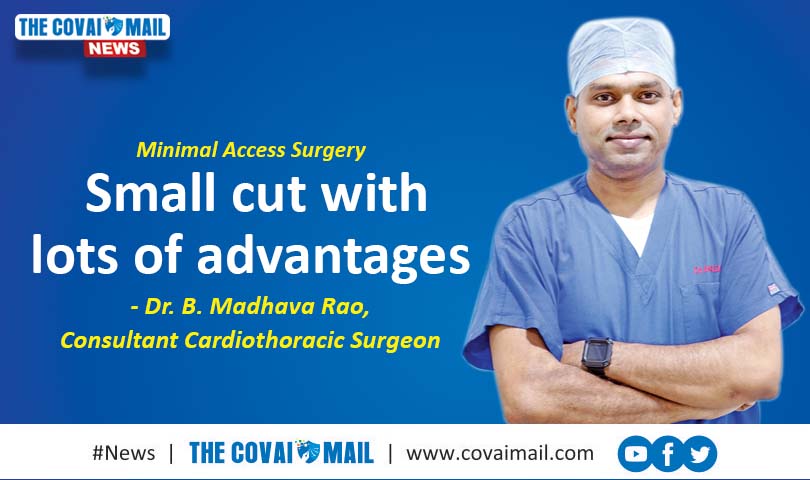
– Dr. B. Madhava Rao, Consultant Cardiothoracic Surgeon, GKNMH
Heart Surgery has always been done most commonly through a cut in the middle of the chest called Sternotomy, which gives good access to the Heart.
99% of all cardiac surgical procedures are done through this approach. Recently with the advancements in technology, advancements in vision instrumentation and imaging, we are able to do some of the cardiac surgery through smaller incision.
Just like how for removing appendix, gallbladder and uterus, people do laparoscopy, Thoracoscopy or Minimal Access Surgery is gaining popularity in cardiac surgery also. The difficulty in cardiac surgery is that the heart is a beating organ with full of blood, and that is why a Minimal Access Surgery for cardiac procedures is a challenge.
So through a small incisions through the right or left side of the chest, certain cardiac surgical procedures can be safely done today. This is called Minimal Access Surgery.
Procedures like Valve Replacement and bypass can be done in selected patients. The advantage is, we don’t cut the center bone so the recovery is faster. The scar is smaller, resulting in better cosmesis.
The technology in this area is fast advancing and now we have latest generation robotics which can do these operation with much smaller incisions. The technology needed for these high end procedures are high; resulting in increased cost which has limited the availability and usage in the Indian context.
These type of procedures are gaining popularity with advancements in consumables as well. In GKNMH we do bypass surgery, valve replacements & valve repairs, and closure of holes in the heart through small incisions in selected patients. We also do video assisted thoracoscopic surgery. This hospital is equipped with all the infrastructure needed to do Minimal Invasive Cardiac Surgery and Thoracoscopic Surgery.
Pediatric Cardiac Surgery
Advanced & Reliable care with best results!
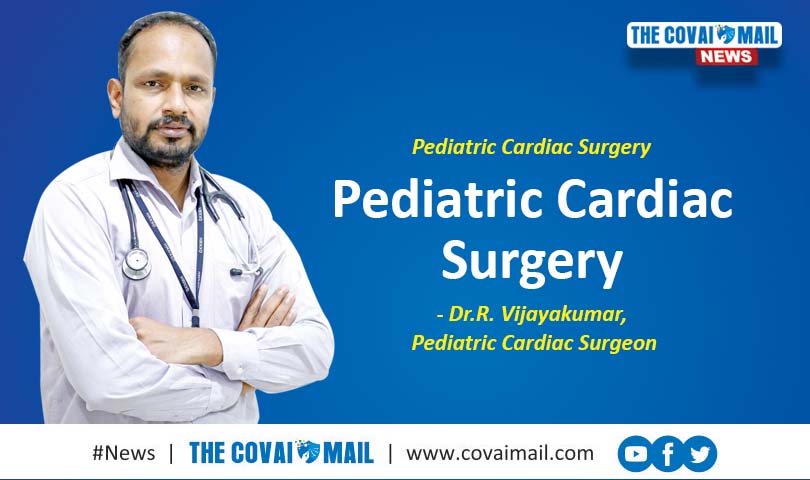
– Dr. R. Vijayakumar, Pediatric Cardiac Surgeon, GKNMH
We provide state of the art cardiac care to children who are being born with birth-related heart problems. We do treat all children irrespective of their age, weight and complexity of disease of the patients with congenital heart diseases.
We treat around 300-350 children with congenital heart problems per year. We have international collaborations with Children’s Heartlink, a NGO that works from USA. We do get our medical volunteers from Mayo Clinic, USA and Boston Children’s Hospital, Boston, USA to come and perform complex surgeries and train our system at GKNM Hospital.
We have a dedicated team of doctors, surgeons, cardiologists, intensivist, anesthesiologist, perfusionist who are experienced in taking care of children with Heart Diseases. Our results are on par with the rest of best centers in the country and also in the developed countries.
Our aim is to provide excellent care to children who are being born with congenital heart disease in and around Coimbatore. Pediatric cardiac surgery is a great service to society, and in our community there are many poor who cannot afford this service. For them we provide help through Chief Minister’s Comprehensive Health Insurance Scheme, and also through the support received from Rotary Clubs, Organization like Genesis and also with the help of CSR activities.
